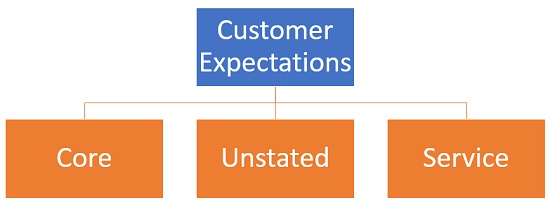- Business Concepts ›
- Marketing and Strategy ›
- Customer Expectations
Customer Expectations
Definition, Importance, Types & Example
This article covers meaning & overview of Customer Expectations from marketing perspective.
What is meant by Customer Expectations?
Customer expectations refers to the expected perceived value, behavior, service or benefits that the customers seek when purchasing a good or availing a service. They are the result of the ‘learning’ process and can be formed very quickly because even first impressions matter a lot. Once established, these expectations can hold significant influence in decision-making processes and can be very hard to change.
Customer expectations are similar to customer requirements but they exceed them. Requirements might be at a basic level. An example can be an air conditioner should be able to give cold and warm air but expectation can be that the AC should have a remote control as well as temperature control. An AC with basic requirement fulfilment might be doing the job well but would not sell in the market as it does not meet the customer expectations.
Also, the customer expectations matter a lot in service industry as it surpassed the core offerings and encompasses the service quality, interactions, actions, staff behavior and quick resolution time.
Importance of Customer Expectations
Most successful companies seek to meet or rather exceed their customers’ expectations in every aspect right from product quality to service. Managing and fulfilling customer expectations are of paramount importance for the success of any brand/company. Customers often want more, better and faster. Expectations from high-performing products are always rising.
Hence managing customer expectations is critical. Without understanding the market trends and customer behavior, we cannot understand the customer expectations as they may be very different from expected customer requirements.
Read More
Customer Expectations Types
There are certain types of customer expectations. Let us discuss the 3 major types:
1. Core Expectations
There are aligned with the customer requirements and expectations from the core product or service offerings.
For Example, they should be able to talk and message using the phone and should also be able to connect to the internet.
2. Unstated Expectations
These are the expectations of the customer which are not stated clearly or expressed by the customer but having them will raise the customer experience and loyalty. A voice controlled AC remote and air filter in an Air conditioner can be an example. Though it is not normally expected but if these are there then customer would try to explore these and eventually buy the product.

3. Service Expectations
While buying a product or a service, customer expects a certain level of experience and interaction with the brand. If the product is good but buying experience is not good then a company may end up losing the customer. Also after buying a product, a customer expects a certain level of After Sales support.
Customer Expectations Example
For example, branded items are often associated with quality. Most customers expect that well-known brands are higher quality and thus evaluate their performance higher than that of an identical product from a little-known brand. This is one of the reasons new brands find it difficult to make it to the consideration set even when they have superior products than current brands.
Other example can be of a smartphone company offering a phone with all basic requirements but it does not sell as it may not have a large screen and Bluetooth connectivity. These 2 requirements are expectations even thought the core requirements of calling, messaging and internet are available in the phone.
Hence, this concludes the definition of Customer Expectations along with its overview.
This article has been researched & authored by the Business Concepts Team which comprises of MBA students, management professionals, and industry experts. It has been reviewed & published by the MBA Skool Team. The content on MBA Skool has been created for educational & academic purpose only.
Browse the definition and meaning of more similar terms. The Management Dictionary covers over 1800 business concepts from 5 categories.
Continue Reading:
What is MBA Skool?About Us
MBA Skool is a Knowledge Resource for Management Students, Aspirants & Professionals.
Business Courses
Quizzes & Skills
Quizzes test your expertise in business and Skill tests evaluate your management traits
Related Content
All Business Sections
Write for Us